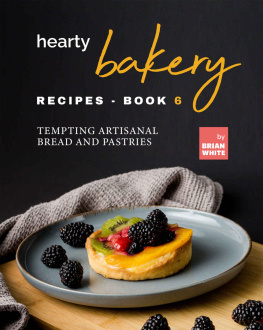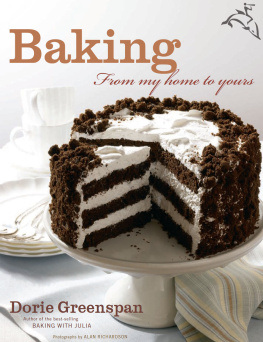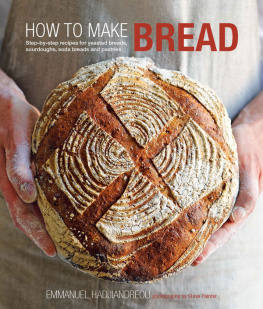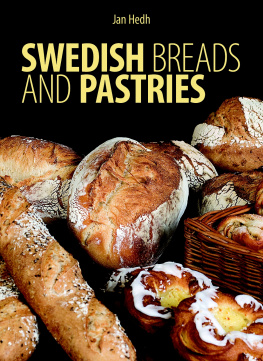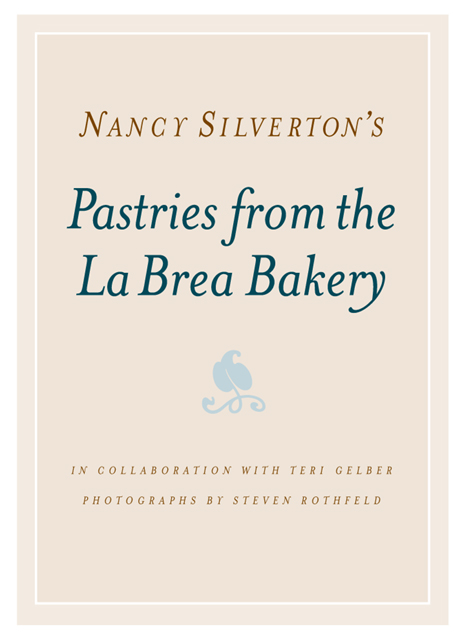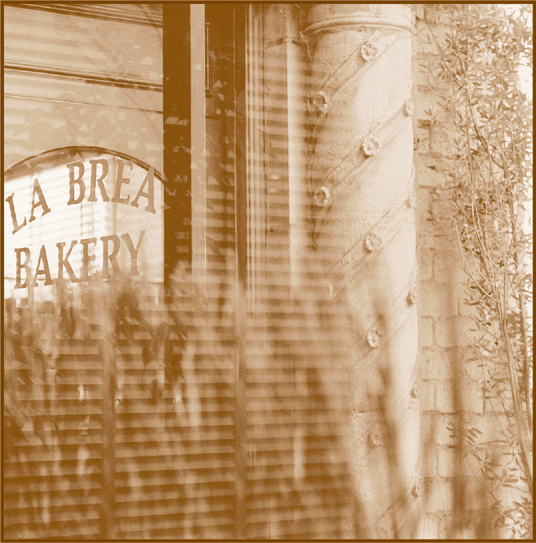Copyright 2000 by Nancy Silverton
All rights reserved under International and Pan-American Copyright Conventions. Published in the United States by Villard Books, a division of Random House, Inc., New York, and simultaneously in Canada by Random House of Canada Limited, Toronto.
V ILLARD B OOKS is a registered trademark of Random House, Inc.
Colophon is a trademark of Random House, Inc.
Library of Congress Cataloging-in-Publication Data
Silverton, Nancy.
Pastries from the La Brea Bakery / Nancy Silverton, in collaboration with Teri Gelber;
photographs by Steven Rothfeld.
p. cm.
ISBN 978-0-375-50193-7
eISBN: 978-0-345-54665-4
1. Desserts. I. Gelber, Teri. II. La Brea Bakery. III. Title.
TX773 .S5214 2000
641.865dc21
99-462216
Villard Books website address: www.villard.com
F IRST E DITION
Book design by Barbara M. Bachman
v3.1
A CKNOWLEDGMENTS
I n a way, the beginnings of this book started in Campaniles tiny, overcrowded upstairs pastry section, where the pastry staff and I first began experimenting with just a handful of breakfast itemsfrom croissants to sticky buns to cinnamon rolls. Because of that, my thanks go to the following:
To Sumi Chang, who was so instrumental in creating our pastries that to this day we think of her as the mother of Campanile breakfastseven when she left us to open the wonderful Europane in Pasadena.
To Gerry Moss, who carried out my vision of what our rustic-style pastries could be, came up with the idea that we should sell as many kinds of sweets as we do bread, and then with energy and passion filled the display cases at the La Brea Bakery store.
To Jose Martinez, our star baker, who for the past few years has baked all night to fill the store shelves, spent all day testing recipes, and could always be relied upon when it came to hiring and training the very best. (Jose, we still havent figured out when you sleep.)
To our talented pastry chef, Kim Sklar, who ran the pastry department with such grace and precision that it allowed me the time and freedom to write this book.
To those who helped us create and perfect: Merilee Atkinson, Jon Davis, Eliza Lee, Michelle Gayer, Marcelino Loya, Annie Miler, Christine Moore, Ramon Ramirez, Margy Rochlin, Joan Ruggles, and Giovanni Sanchez.
To those whove spent so many hardworking years behind the La Brea Bakery store counter, but who never forget to smile: manager Lora Davis, and her teamSandra Avelar, Dakota Bertrand, Mia Elkan, Theresa Limon. And to George Rose, our vested authority on all things so very La Brea.
A special thanks to Jack Stumpf, Jessica Buonocore, and Paul Schrade, all of whom took recipes that might be otherwise impossible for a novice chef, vetted them, and made them user-friendly.
No baking book of mine would be complete without the expertise and recipe contributions of my friend Izzy Cohen.
To Christopher Gelber, who made me listen to his opinions, even when I didnt ask for them.
To my editor, Peter Gethers, and his assistant, Shauna Toh, who saw me through this third collaboration with support and encouragement.
To my production editor, Benjamin Dreyer, who has always forgiven the excessive amount of corrections I ask for (but is especially tolerant right after Ive sent him chocolate chip cookies and chocolate cherry bread).
To my agent, Janis Donnaud, who knows the recipe for a great deal.
To Margy Rochlin, who has turned popping in for a visit into a lesson in the art of true companionship. We knew our Caramel Candy Kisses were perfect when she asked for just one more.
To my husband, Mark Peel, and my children, Vanessa, Ben, and Oliver.
To the best (but slowest) photographer, Steven Rothfeld, who believes that a blueberry scone deserves to be as well lit as Grace Kellyeven if it takes two hours to set up the shot.
To my coauthor Teri Gelber (pronounced Gel-BURR), whom Ive known for so many years, in so many capacities. I cant thank her enough for the endless hours she spent with me in front of the computer, getting my voice exactly right and translating my pastries into words.
C ONTENTS
T O THIS DAY, MY HEART STILL POUNDS WHEN I WALK INTO L A B REA B AKERY .
I NTRODUCTION
B ack in 1989, when the La Brea Bakery first opened, we sold only bread. Customers would walk in, look around, and say, Bread, is that it? Some would then leave with a loaf; others would advise me that my dark, flour-dusted creations were burnt and dirty; but most were too skeptical to even try one of the large, crusty, hand-shaped loaves. Bread was something most Americans bought in plastic bags at the supermarket. Real bakeries sold cakes and cookies. With my reputation as a pastry chef, I was expected to satisfy their sweet tooth, not to provide something most often used to sandwich ham and cheese. But the demanding life of a bread baker was so new to me, it needed all of my attention. I just didnt have time for pastries. Besides, our space was too small to accommodate anything more than a display rack and the essential bread-making equipment: a mixer, some worktables, and a hearth-style oven.
Over time, a hard sell became an addiction. The bakery became so successful, we were running out of bread earlier and earlier each day. To keep our customers satisfied, wed have to bake more. To bake more, we needed extra space. To gain extra space, we were forced to move our production to a larger facility. Suddenly, our tiny, chaotic retail bakery was transformed into a vast and cavernous shell with unused equipment and a lonely rack of bread. The charm of a working bakery was lost. The activity and smells of baking bread were replaced by the fumes of a delivery truck that dropped off the daily bake to be sold in the storefront.
To bring life back, we would have to bake again. And why not bake what people wanted in the first place: sweets? Not just any sweets, but the kind of sweets that I wanted to bake, that I wanted to eat, and that I wanted to look at. I didnt want refrigerated cases shelved with fragile cakes, elaborately constructed of countless creamy layers, architectural and overly decorated. Those show-off desserts are seldom about texture and flavor, but about the costly tools and learned techniques it takes to make them. Furthermore, fancy pastries would hardly make sense alongside my hearty, country-style bread.
The pastries we make are deliciously simple and rustic and never too sweet. Woven into many of them are my favorite flavors: butter, cinnamon, nuts, and fruit. Theyre familiar, uncomplicated, and satisfying. One taste and youre instantly comforted. Inspired by a sweet memory from childhood, a European classic, or a time-honored bakeshop standard, they are flavors you never tire of. Like my bread, these are pastries you want to eat every day.
Except for a sprinkling of nuts, a dusting of powdered sugar, or a drizzling of glaze, no fastidious finishing work is necessary. Once the pastry is in the oven, the bakers job is done. As these doughs and batters cook, their intrinsic beauty naturally evolves. Rich colors and alluring textures take us by surprise. Flaky, soft, or crumbly, tender, moist, or crisp, these treats compel you to take another bite. As the sugars caramelize in the oven, they accent the crust with a lustered sheen. Heat and alchemy produce a palate of deep, earthy tones from burnished reds and browns to dull and shiny golds and yellows. Scorched fruit might peek through the top of a rise and swell, each one with a mind of its own. No matter, all are unique. Even when baked in a mold, no two turn out the same.


